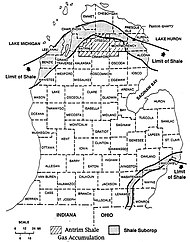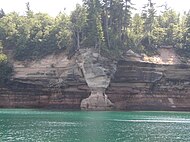
The Eagle Sandstone, originally the Eagle Formation, is a geological formation in Montana whose strata date back to the Late Cretaceous. It is a light to brownish gray to pale yellow-orange, fine-grained sandstone. It contains areas of crossbedding and local shale members. It contains large sandy calcareous concretions. Its thickness varies from 100 to 350 feet due to the lens nature of the individual sandstone layers and local interbedded sandy shale layers.

The Waverly Group is a geologic group in Michigan and Ohio. It preserves fossils dating back to the Carboniferous period.
The Saginaw Group is a geologic group in Michigan composed of sedimentary rock deposited during the Pennsylvanian Period (circa 323.2 million years ago to 298.9 million years ago. Saginaw group rocks include sandstone, shale, coal, and limestone of fresh water, brackish, and marine origin. Fossils dating back to the Penssylvanian Period can be found in Saginaw Group formations.
The Waverly Sandstone is a geologic formation in Michigan. It preserves fossils dating back to the Carboniferous period.
The Georgian Bay Formation is a geologic formation in Michigan and Ontario. It preserves fossils dating back to the Ordovician period. The type locality of the formation is on East Meaford Creek, south shore of Nottawasaga Bay, Georgian Bay.

The Hinton Formation is a geologic formation in West Virginia. It preserves fossils dating back to the Carboniferous period. It is mainly made up of limestone, sandstone, and shale.
The Williamsport Sandstone is a sandstone geologic formation in West Virginia, Virginia, Pennsylvania, and Maryland. The formation includes the Cedar Creek Limestone member. Near Cumberland, Maryland it includes the Cedar Creek Limestone member. It preserves fossils dating back to the Silurian period.
The Sylvania Sandstone is a geologic formation in Ohio and Michigan. Its type locality is Sylvania, Ohio. It preserves fossils dating back to the Devonian period.

The Cuyahoga Formation is a geologic formation in Ohio. The age of the formation is difficult to determine, because of a lack of diagnostic fossils. Roughly, the formation dates from the Late Kinderhookian to the Middle Osagean. Eight members are recognized, among them the Orangeville Shale, Sharpsville Sandstone, and Meadville Shale.
The Java Formation is a geologic formation in Kentucky, New York, Ohio, Pennsylvania, Tennessee, Virginia, West Virginia. It preserves fossils dating back to the Devonian period. The formation comprises the Pipe Creek Shale, Wiscoy Sandstone Member in New York, and Hanover Shale Member except in Tennessee.

The Jordan Sandstone is a geologic formation in Wisconsin. It preserves fossils dating back to the Cambrian period.
The Sawatch Formation is a geologic formation in eastern Colorado. It is a sedimentary sequence formed approximately 530 million years ago during a marine transgression. It preserves fossils dating back to the Cambrian period. It is composed of glauconitic and quartz-rich sandstone.
The Troublesome Formation is a geologic formation in Colorado. It preserves fossils dating back to the Neogene period. It consists of Pale shades of pink, tan, gray, green, and white interbedded siltstone and mudstone, less abundant arkosic sandstone and conglomerate, and sparse limestone and altered crystal-vitric ash and tuff; generally poorly consolidated. It includes atypical deposits containing abundant pink, granitic cobbles and boulders along the western parts of the outcrop in the west-central and southwestern parts of the Granby Quadrangle, Fossil mammals from three sites indicate a late Oligocene age.
The Harding Sandstone is a geologic formation in Colorado. It preserves fossils dating back to the Ordovician period.

The Maroon Formation is a geologic formation in Colorado. It preserves fossils dating back to the Permian period. It is the primary formation of sandstone that lends the vivid red color to the hills around Glenwood Springs, Colorado.

The Tunnel Mountain Formation is a geologic formation that is present on the western edge of the Western Canada Sedimentary Basin in the Canadian Rockies of western Alberta. Named after Tunnel Mountain near Banff, it was deposited during the Early Pennsylvanian sub-period of the Carboniferous period.
The Bois Blanc Formation is a geologic formation in Michigan. It preserves fossils dating back to the Devonian period.
The Parma Sandstone is a geologic formation in Michigan. It preserves fossils dating back to the Carboniferous period.
The Pocahontas Formation is a coal-bearing geologic formation in West Virginia. It preserves fossils dating back to the Carboniferous period.
The Princeton Sandstone is a geologic formation in West Virginia. It preserves fossils dating back to the Carboniferous period.









